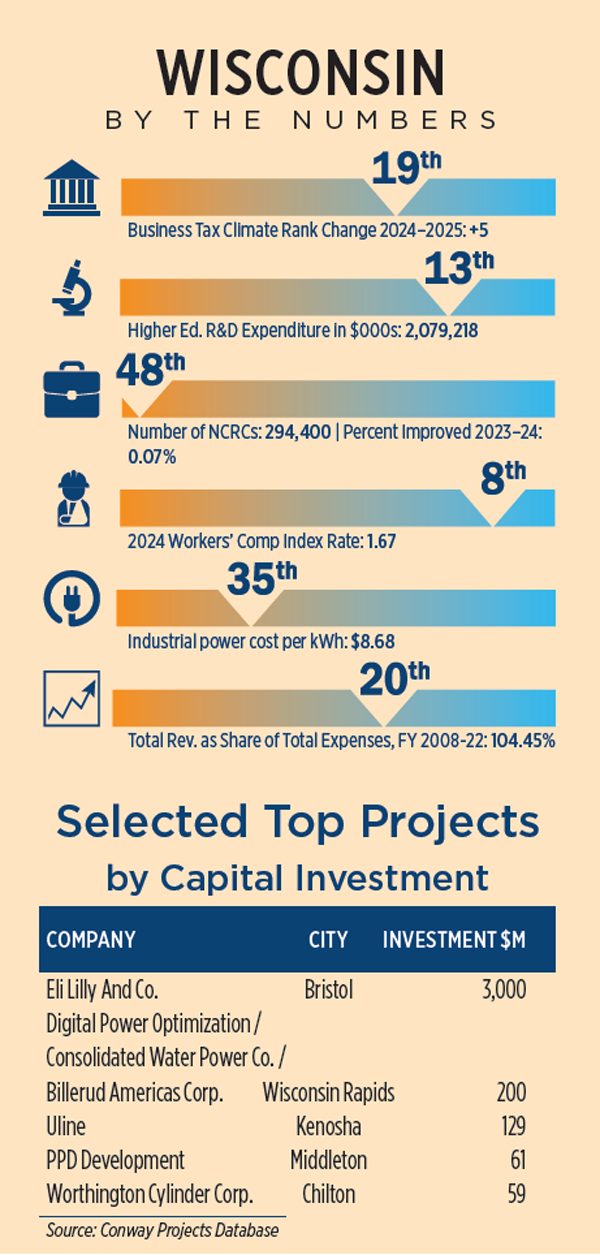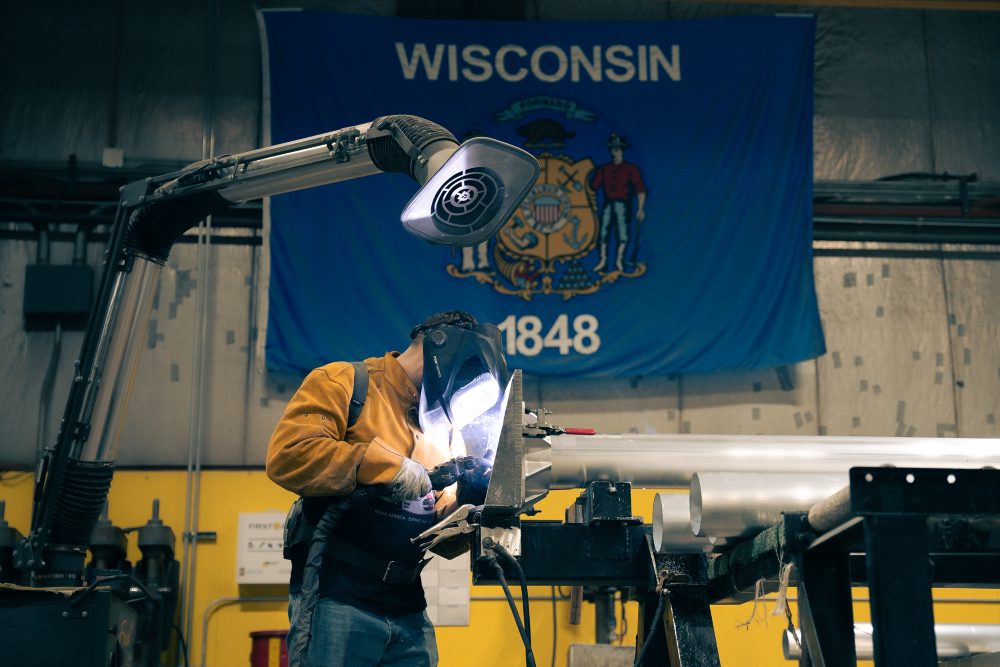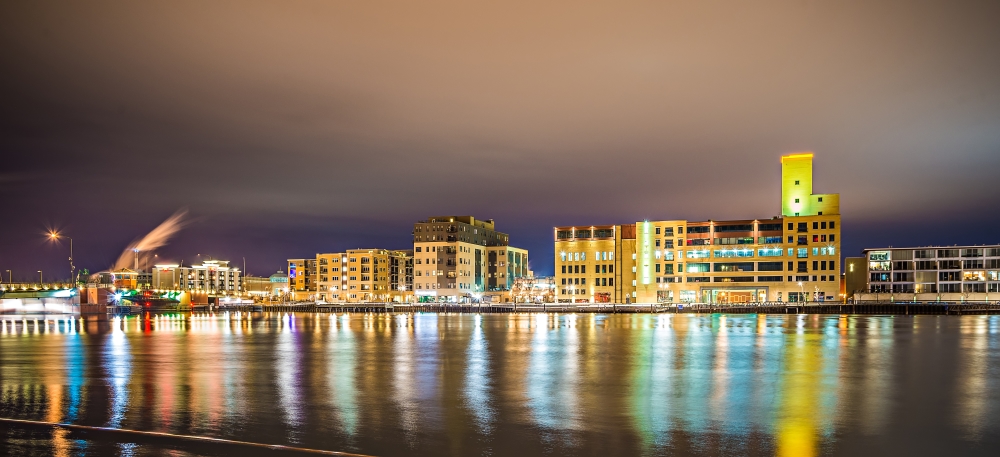Wisconsin flexes its muscle beyond the bright lights of the NFL.
For three days in late April, virtually every camera in the sports world trained its lens squarely on one city: Green Bay, Wisconsin.
Hosting the NFL Draft commands that level of attention. From April 24 to 26, more than 600,000 people showed up at the Green Bay Packers’ Lambeau Field and neighboring Titletown to enjoy the festivities of pro football’s second biggest spectacle. Among the attendees were thousands of media members from across the country and the globe.
Most spectators and media types came to find out where the college stars of today will play in the National Football League, but more than a few visitors came to kick the tires on Wisconsin’s business landscape. About 15 people participated in a site selectors familiarization tour hosted by the Wisconsin Economic Development Corp. and New North Inc., the economic development group for greater Green Bay and northeast Wisconsin.
While the sports world waited breathlessly to see who would go No. 1 overall, the site selectors and I wanted to see what Wisconsin looked like far away from the media glare and broadcaster scrutiny.

Wisconsin passed this test with flying green and gold colors. The Badger State handled the fanatical crowds with ease, but more importantly, revealed why it has become a force at winning highly competitive economic development projects.
One glance at the Conway Projects Database shows this progress. From Microsoft’s $3.3 AI data center development in Mount Pleasant to Eli Lilly’s $3.5 billion expansion of its pharmaceutical manufacturing campus in Kenosha County, Wisconsin is experiencing a technology and manufacturing boom.
Moreover, it is happening in every quarter of the state. Rosewood Dairy/Renard’s Cheese announced a 50,000-sq.-ft. remodel and expansion in Algoma. AmeriLux acquired 22.5 acres in De Pere for a $40 million, 500,000-sq.-ft. factory that creates 100 jobs; and Dakota Supply Group is building a 39,000-sq.-ft. facility in Sheboygan.
For three days, I went searching for answers for what’s driving this investment binge. A business tax credit incentive is playing a role, as is continued investment into talent attraction and creation of investment-ready sites for business. From Milwaukee to Appleton to Eau Claire, the folks who run growing firms are finding the right mix of business climate and workforce to make expansion plans work and bottom lines shine.
Engineers Lighting the Way
Adam Rupp, co-founder and president of Wisconsin Lighting Lab Inc. in Fond du Lac, is a local business leader who’s bullish on the Badger State.

“You can throw a football in Wisconsin and hit a machine shop. They are so important to the economy and the supply base.”
— Adam Rupp, President & Co-founder, Wisconsin Lighting Lab Inc.
“About three years ago, we doubled the size of our building to over 60,000 square feet, which enabled us to increase our throughput. We are doing this through equipment upgrades and process improvements,” says Rupp. “At the end of this year, we are putting in a very high-end powder-coating system. We do a lot of low to high-volume projects. The space that we plan will have a human craftsman touchpoint.”
Rupp’s firm, known as WiLL, completed the $5 million manufacturing operations expansion in late 2022. Since then, it has multiplied production by a factor of 10.
Rupp says that Wisconsin is known worldwide for its machine shops. “You can throw a football in Wisconsin and hit a machine shop,” he says. “They are so important to the economy and the supply base. We utilize that supply chain. A lot of engineers and builders are here in Fond du Lac County. You can attract good young talent here.”
When I asked him what propelled his high-end lighting manufacturing company to invest millions into expanding its facility footprint and hiring additional workers, here is what he said: “We are a good representative of the small business manufacturing community in Wisconsin. We adopted our name for a reason. We are very proud of where we come from. We deliver professional grade technology. That is what Wisconsin is known for.”

Wisconsin Lighting Lab Inc. (WiLL) workers produce world-class industrial lighting systems from their main campus in Fond du Lac.
Photo courtesy of WiLL
He also likes the fact that Wisconsin schools train students to be selective in who they work for.
“I have a good story that exemplifies that,” says Rupp, a 2007 graduate of the Lubar College of Business at University of Wisconsin-Milwaukee. “About 12 years ago, I was about to hire our first intern. He was a local kid from a local college. He was all set to come on board when I got a call from his professor, who had driven over to see our manufacturing lot. He told me that he would not let his student work for us. ‘I do not consider you to be a real business,’ he said. At the time, we didn’t look like much from the outside; and the professor said that he would never let one of his students work at a place that looked like this. That lit a fire under me. It made me want to make our company a place where people would want to work.”
The motivational match was lit. Changes were made, millions were spent on upgrades, and WiLL has since gone on to become a major lighting supplier for Walt Disney World in Florida and athletic stadiums around the country.
New Incentive: The Cherry on Top?
Missy Hughes, secretary of the Wisconsin Economic Development Corp. (WEDC), says that companies like WiLL can be found all over the state. They thrive, she says, because of their ability to recruit the best and brightest talent from a state that places a high priority on education and workforce development.
“Wisconsin is on the plus side when it comes to attracting talent,” says Hughes. “We are seeing the needle move in our direction. The good work we’ve been doing in creating quality of life and attracting talent is paying off.”
Meanwhile, a new incentive is turning corporate heads. “The incentive we are most excited about is the change that has been made to our business tax credit incentive,” says Hughes. “It enables employers to receive refundable tax credits for investment without job creation. In a universe where workforce is a challenge, Wisconsin has really taken a step forward.”

Sister Bay sunset and water views on the Door County peninsula.
Photos courtesy of Door County Economic Development Corp.
While large tech companies like Microsoft and Eli Lilly grab headlines when they announce their big new investments, Wisconsin’s bread and butter — and cheese — come in the form of small to medium-sized manufacturers. One place that is chock-full of them is Door County, a scenic peninsula resting between the Bay of Green Bay and Lake Michigan.
Sometimes called the Nantucket of Wisconsin, Door County is home to 30,000 people, a thriving year-round tourism sector and a bustling manufacturing base that produces boats, machinery, marine lifts, cherry wine and cheese.

“We have a deep history of manufacturing in the county.”
— Michelle Lawrie, Executive Director, Door County Economic Development Corp.
“We have a deep history of manufacturing in the county,” says Michelle Lawrie, executive director of the Door County Economic Development Corp. (DCEDC). “Our number one industry is shipbuilding and repair. Our companies do both commercial shipbuilding and repair work and military marine contracts. The original shipyard in Door dates back to 1918.”
Folks who live in Door tend to work in manufacturing, commercial fishing, tourism and hospitality, or the food industry. In 2023, tourists spent $497 million in the county, an increase of 5.6% from 2022. Tourism’s total economic impact in 2023 in Door totaled $620 million and involved the employment of 3,444 people.
“Visitors attend weddings, celebrate bridesmaid parties, attend our annual Cherry Drop, go to our many fall festivals, or even watch the filming of ‘A Cherry Pie Christmas,’ ” Lawrie says of the new holiday-themed movie set for release in late 2025.
If you want to know what Door County and its people are like, film writer and director John Stimpson offers this: “Door County is the perfect setting for the film with its local traditions and beautiful scenery, rich agricultural history with cherries, commercial fishing and dairy farming. Together with the importance of family, all of these elements are integral storylines in the film and are also authentic to the Door County community. Everyone throughout the state has been so helpful in getting this off the ground. It’s been a real pleasure to shoot in Wisconsin.”

